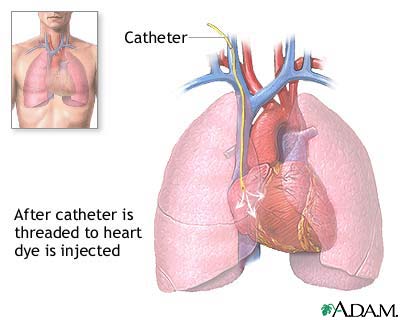


 |  |  |
| | ||
Cardiac catheterization

Cardiac catheterization is used to study the various functions of the heart or to obtain diagnostic information about the heart or its vessels. A small incision is made in an artery or vein in the arm, neck, or groin. The catheter is threaded through the artery or vein into the heart. X-ray images called fluoroscopy are used to guide the insertion. When the catheter is in place, dye is injected to visualize the structures and vessels within the heart.
Update Date: 9/3/2008 Updated by: Larry A. Weinrauch, MD, Assistant Professor of Medicine, Harvard Medical School, Cardiovascular Disease and Clinical Outcomes Research, Watertown, MA. Review provided by VeriMed Healthcare Network. Also reviewed by David Zieve, MD, MHA, Medical Director, A.D.A.M., Inc.
